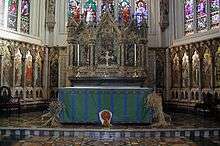Thomas Earp (sculptor)
| Thomas Earp | |
|---|---|
 | |
| Born |
1828 Nottingham, UK |
| Died | 1893 |
| Nationality | British |
| Known for | sculpture, stone carving |
Thomas Earp (1828–1893) was a British sculptor and architectural carver who was active in the late 19th century. His best known work is his 1863 reproduction of the Eleanor Cross which stands at Charing Cross in London.[1] He specialised in sculpture for Gothic Revival churches and worked closely with the architect George Edmund Street in the 1860s and 1870s.
Early life and career
Earp was born in Nottingham, England. He studied at the Nottingham School of Art and Design and after completing his studies in the early 1850s went to work for the building contractor George Myers (who himself worked extensively for Pugin) in London.[2]
Around 1851 Earp founded his own architectural sculpture practice. By 1864 he was established at 1 Kennington Road, Lambeth, and employed 24 people. One of his projects, a marble and alabaster reredos, pulpit and baptismal font for the Church of St John the Baptist, Huntley, was particularly acclaimed and was exhibited at the Great Exhibition of 1862.[2]
Earp and Hobbs Ltd
Earp's practice expanded in 1864 when he went into partnership with another sculptor, Edwin Hobbs Senior (c.1841-1904). Together they opened premises in Chorlton-upon-Medlock, Manchester on Lower Mosley Street, later moving to premises in Moss Side. While Hobbs was based in Manchester, Earp worked from the London office at 32 Canterbury Place, Lambeth Walk. In the late 1880s the business was renamed Earp, Son and Hobbs, and by 1900 it was trading as Earp and Hobbs Ltd. Thomas Earp's son, Edgar Earp worked in the practice along with Edwin Hobbs Junior.[3]
Works


Works include:
- carved pulpit, Church of St James the Less, Pimlico, London (1862)[4]
- reredos at St Mary Magdalene, Paddington[5]
- reredos at St Peter, Kirkgate, Leeds[6]
- Horton family mausoleum, All Saints' churchyard, Middleton Cheney, Northamptonshire (William Wilkinson, 1866–67)[7]
- architectural detail, St. James's Church, Milnrow, Lancashire (GE Street, 1868–69)
- City Police Courts, Manchester, (Thomas Worthington, 1867–73);
- Annunciation group, Cathedral Church of St Marie, Sheffield (1879)
- reredos,Cathedral Church of St Andrew, Sydney (1886)
- the baptismal font in Rochester Cathedral (1893)
- Reredos, St James's Episcopal Church, Leith (1862–65)
- the Eleanor Cross, Charing Cross, London (1863)
- Reredos in the Lady Chapel, St Margaret's Convent of the Ursulines of Jesus, The Grange, Edinburgh (1877)
- architectural detail, St Silas's Church, Glasgow (John Honeyman, 1864)
- St John the Divine, Kennington, London
- Holy Trinity Church, Hastings
- St Leonard's Church, Bridgnorth
- St Jude's Church, Kensington, London
- pulpit, St Michael and All Angels Church, Hughenden, Buckinghamshire
- pulpit, Christ Church Cathedral, Dublin[8]
References

- ↑ Mitchell, Anthony; Mitchell, Olive (2002). Thomas Earp: Eminent Victorian Sculptor. Baron Books. ISBN 9780860236696.
- 1 2 "Thomas Earp (1828-1893)". The Victorian Web. Retrieved 18 April 2012.
- ↑ "Earp and Hobbs Ltd.". Mapping the Practice and Profession of Sculpture in Britain and Ireland 1851-1951. Retrieved 18 April 2012.
- ↑ "Pulpit in St James the Less". Victorian Web. Retrieved 18 April 2012.
- ↑ "Reredos at St Mary Magdalen in Paddington". Victorian Web. Retrieved 18 April 2012.
- ↑ "St Peter, Kirkgate, Leeds, by R.D. Chantrell (1793–1872)". Victorian Web. Retrieved 18 April 2012.
- ↑ Pevsner, Nikolaus; Cherry, Bridget (revision) (1973) [1961]. Northamptonshire. The Buildings of England (2nd ed.). Harmondsworth: Penguin Books. p. 306. ISBN 0-14-071022-1.
- ↑ Casey, Christine (2005). The Buildings of Ireland: Dublin. New Haven: Yale University Press. p. 334. ISBN 978-0-300-10923-8.
External links
 Media related to Thomas Earp (sculptor) at Wikimedia Commons
Media related to Thomas Earp (sculptor) at Wikimedia Commons